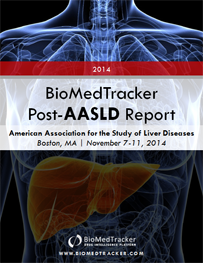Report Library
All Reports
2014 BioMedTracker Post-AASLD Report
December 16, 2014
The American Association for the Study of Liver Diseases (AASLD) 2014 Annual Meeting, also known as “The Liver Meeting”, was held
in
Boston, MA November 7-11.
With the recent approvals for Gilead’s (GILD) second -generation regimen which combines its nuc, sovaldi (approved) in a fixed dose
with
its
NS5a inhibitor, ledipasvir (Harvoni), there is now a highly effective on-label treatment for GT1 patients. We believe that this will be the
dominant regimen moving forward. Additionally, there is impending approval of ABBV’s 3D combination with an expected PDUFA
decision
on
December 19, 2014. We expect the ABBV 3D regimen to be competitive in a few subgroups of patients and will likely have to compete
on
price with Harvoni to gain even modest market share.
At this year’s AASLD, the big questions were how will the ABBV combination be priced, and if it will increase patient access to treatment.
Pending approval of this competitor, there has been widespread payer pushback on reimbursement, particularly to early-stage HCV
patients.
AASLD believes this pushback was partly due to a misinterpretation of its guidelines which the group expects to update by the end of
this
year. In EU, the expected strategy is to only treat patients with >F3 for the near future. See US/EU physician survey result below
and
a
full
survey here.
As cost of treatment remains a dominant issue, the failed attempts at shortening the duration of treatment presented at the conference.
Particularly, C-SWIFT data combining Merk’s two drug regimen with sofosbuvir, were disappointing at both 4 and 6 weeks. However,
clinicians widely hold that 8-12 week durations are sufficient, and that shorter durations will get there eventually but are only a concern
for
payers. The reemergence of the addition of ribavirin to regimen to shorten treatment durations for treatment-experienced and GT3
patients
was
another major theme of the conference. This would reduce cost, but the strategy would need to be tailored to minimize anemia risks
associated with ribavirin.
Finally, the positive news from this meeting was that a number of the previously difficult–to-treat subgroups responded favorably to
treatment:
decompensated cirrhotics, HIV coinfected, and transplant patients. However, more effective treatments are still needed for patients with
significant kidney disease.
The following report provides an overview of important data events at this year’s conference with BMT analysis. This report was
supplemented with insight from a US and a European Key Opinion Leader (KOL) in the field of hepatology/gastroenterology and a
survey of
27
US and 22 EU hepatologists/gastroenterologists. To purchase an add-on subscription to all HCV reports on KOL Insight, please email
Client Services. Click on these links for in-depth interviews with both
EU and US Key Opinion Leaders.
BioMedTracker recently updated its Hepatitis C market forecasts. See HCV Market forecast below. We have also included a full list of
AASLD
events, select 2015 HCV catalysts, and projected HCV US approvals.
For the full report, please download the PDF version at the top of this page.
For our disclosures, please read the BioMedTracker Research Standards.
| Indications Covered: |
Hepatic Fibrosis
Hepatitis B (HBV) Treatment (Antiviral) Hepatitis C (HCV) (Antiviral) Hepatocellular (Liver) Cancer (HCC) (Including Secondary Metastases) Liver Failure / Cirrhosis Non-Alcoholic Steatohepatitis (NASH) |
Additional Resources:
